MANM4000 Introduction to Management: Case Study - Boss Challenge
VerifiedAdded on 2023/06/15
|9
|2078
|256
Case Study
AI Summary
This case study solution analyzes the conflict between a boss and subordinate, identifying management issues such as lack of roles, cooperation, overconfidence, misuse of power, and behavioral conflicts. These issues impact organizational performance and employee motivation. The solution applies motivational theories like Acquired Needs, ERG, and Herzberg's Two-Factor Theory, as well as Human Resources theories like AMO and the Harvard model. Furthermore, it explores leadership theories including Transformational and Contingency theories to suggest resolutions. The analysis emphasizes the importance of addressing conflicts to improve overall organizational growth and employee satisfaction. Desklib offers a platform to access similar solved assignments and past papers for students.
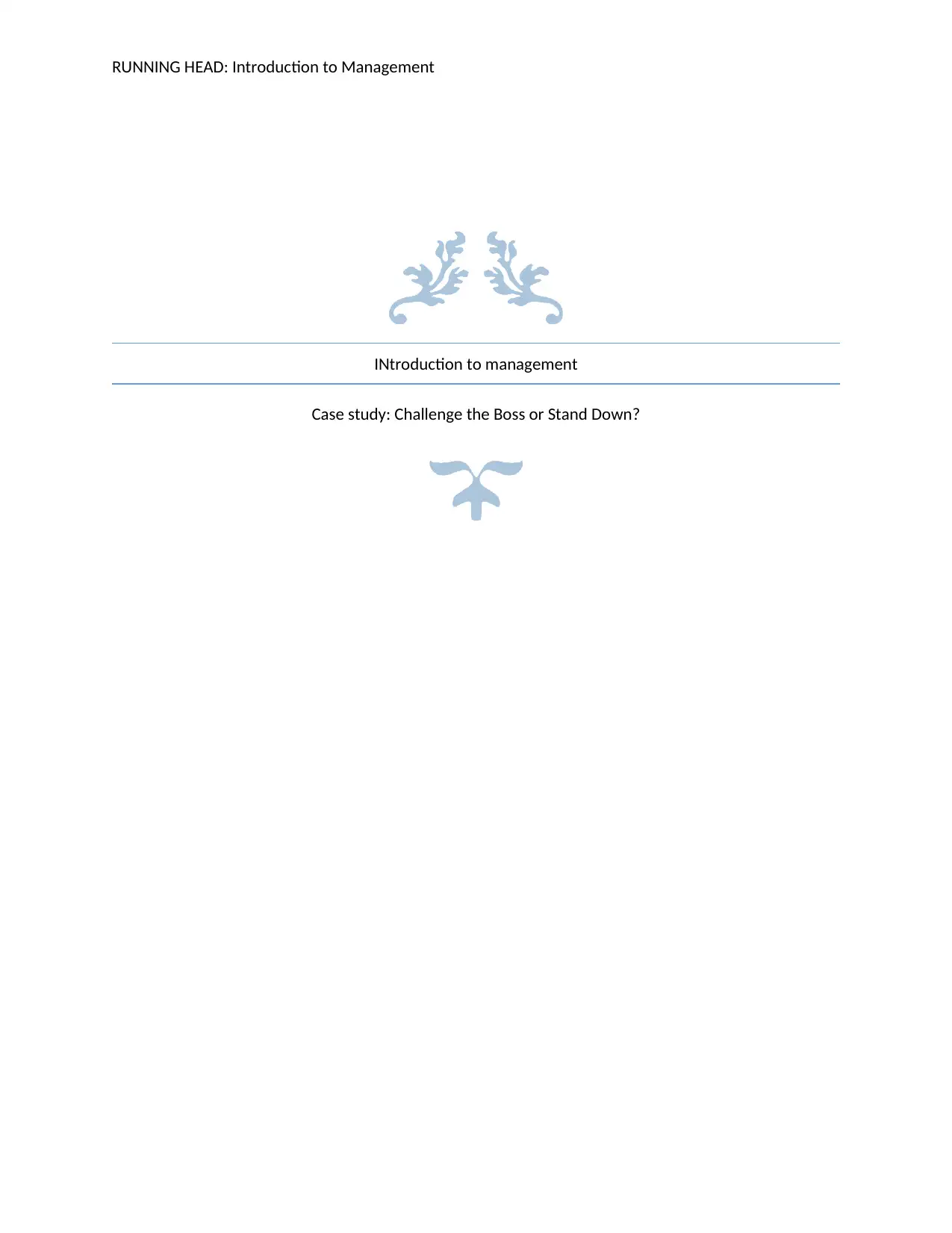
RUNNING HEAD: Introduction to Management
INtroduction to management
Case study: Challenge the Boss or Stand Down?
INtroduction to management
Case study: Challenge the Boss or Stand Down?
Paraphrase This Document
Need a fresh take? Get an instant paraphrase of this document with our AI Paraphraser
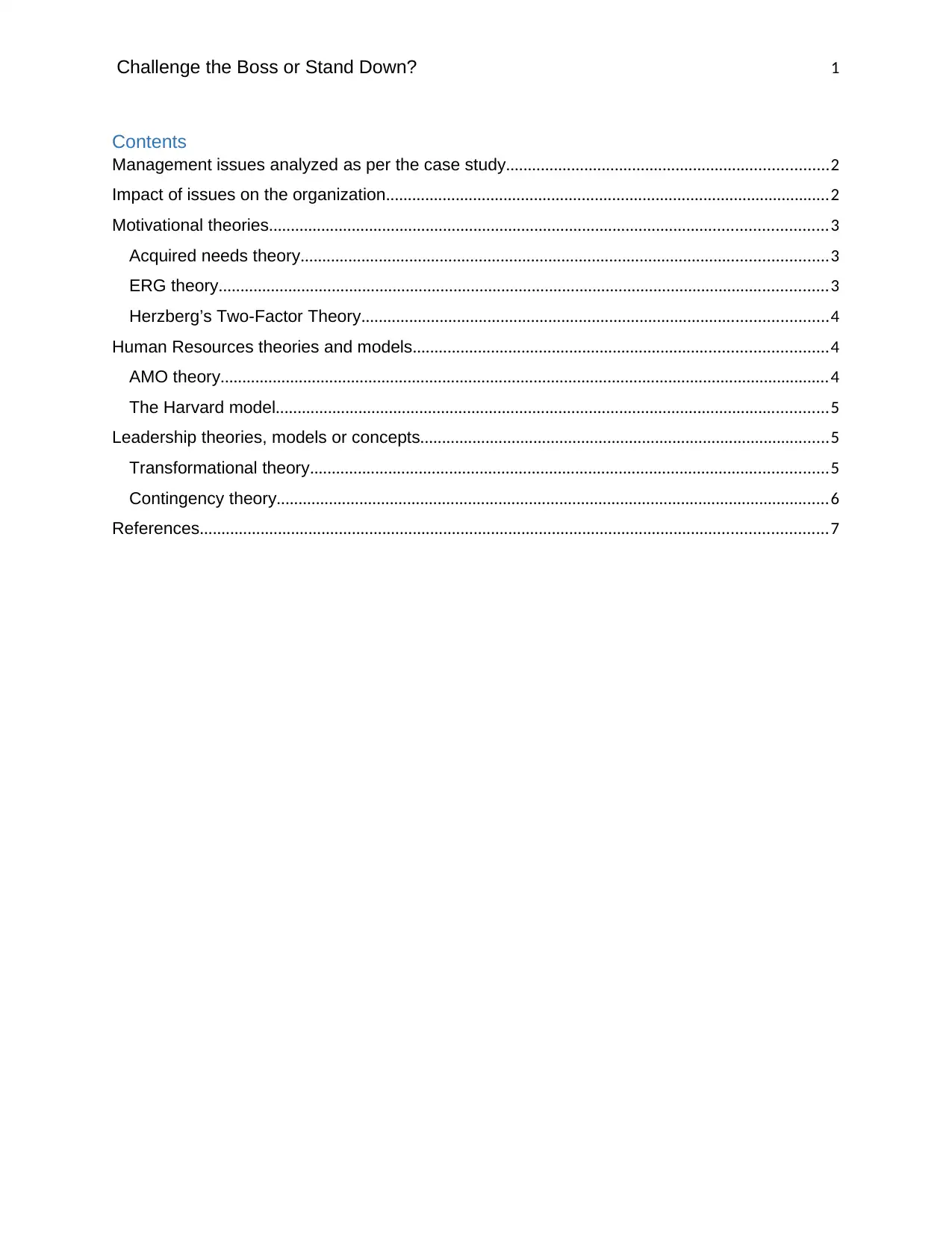
Challenge the Boss or Stand Down? 1
Contents
Management issues analyzed as per the case study..........................................................................2
Impact of issues on the organization......................................................................................................2
Motivational theories................................................................................................................................3
Acquired needs theory.........................................................................................................................3
ERG theory............................................................................................................................................3
Herzberg’s Two-Factor Theory...........................................................................................................4
Human Resources theories and models...............................................................................................4
AMO theory............................................................................................................................................4
The Harvard model...............................................................................................................................5
Leadership theories, models or concepts..............................................................................................5
Transformational theory.......................................................................................................................5
Contingency theory...............................................................................................................................6
References................................................................................................................................................7
Contents
Management issues analyzed as per the case study..........................................................................2
Impact of issues on the organization......................................................................................................2
Motivational theories................................................................................................................................3
Acquired needs theory.........................................................................................................................3
ERG theory............................................................................................................................................3
Herzberg’s Two-Factor Theory...........................................................................................................4
Human Resources theories and models...............................................................................................4
AMO theory............................................................................................................................................4
The Harvard model...............................................................................................................................5
Leadership theories, models or concepts..............................................................................................5
Transformational theory.......................................................................................................................5
Contingency theory...............................................................................................................................6
References................................................................................................................................................7
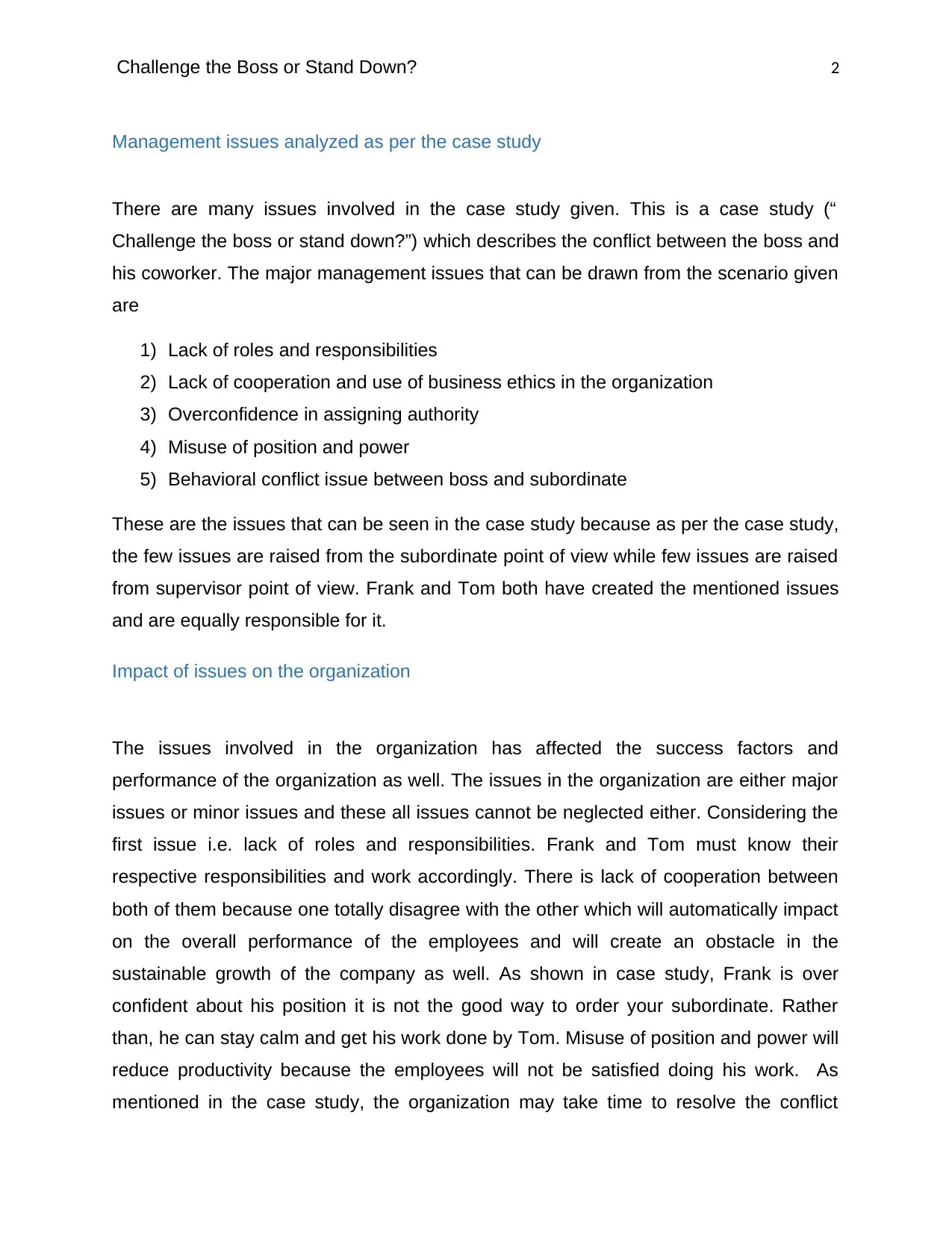
Challenge the Boss or Stand Down? 2
Management issues analyzed as per the case study
There are many issues involved in the case study given. This is a case study (“
Challenge the boss or stand down?”) which describes the conflict between the boss and
his coworker. The major management issues that can be drawn from the scenario given
are
1) Lack of roles and responsibilities
2) Lack of cooperation and use of business ethics in the organization
3) Overconfidence in assigning authority
4) Misuse of position and power
5) Behavioral conflict issue between boss and subordinate
These are the issues that can be seen in the case study because as per the case study,
the few issues are raised from the subordinate point of view while few issues are raised
from supervisor point of view. Frank and Tom both have created the mentioned issues
and are equally responsible for it.
Impact of issues on the organization
The issues involved in the organization has affected the success factors and
performance of the organization as well. The issues in the organization are either major
issues or minor issues and these all issues cannot be neglected either. Considering the
first issue i.e. lack of roles and responsibilities. Frank and Tom must know their
respective responsibilities and work accordingly. There is lack of cooperation between
both of them because one totally disagree with the other which will automatically impact
on the overall performance of the employees and will create an obstacle in the
sustainable growth of the company as well. As shown in case study, Frank is over
confident about his position it is not the good way to order your subordinate. Rather
than, he can stay calm and get his work done by Tom. Misuse of position and power will
reduce productivity because the employees will not be satisfied doing his work. As
mentioned in the case study, the organization may take time to resolve the conflict
Management issues analyzed as per the case study
There are many issues involved in the case study given. This is a case study (“
Challenge the boss or stand down?”) which describes the conflict between the boss and
his coworker. The major management issues that can be drawn from the scenario given
are
1) Lack of roles and responsibilities
2) Lack of cooperation and use of business ethics in the organization
3) Overconfidence in assigning authority
4) Misuse of position and power
5) Behavioral conflict issue between boss and subordinate
These are the issues that can be seen in the case study because as per the case study,
the few issues are raised from the subordinate point of view while few issues are raised
from supervisor point of view. Frank and Tom both have created the mentioned issues
and are equally responsible for it.
Impact of issues on the organization
The issues involved in the organization has affected the success factors and
performance of the organization as well. The issues in the organization are either major
issues or minor issues and these all issues cannot be neglected either. Considering the
first issue i.e. lack of roles and responsibilities. Frank and Tom must know their
respective responsibilities and work accordingly. There is lack of cooperation between
both of them because one totally disagree with the other which will automatically impact
on the overall performance of the employees and will create an obstacle in the
sustainable growth of the company as well. As shown in case study, Frank is over
confident about his position it is not the good way to order your subordinate. Rather
than, he can stay calm and get his work done by Tom. Misuse of position and power will
reduce productivity because the employees will not be satisfied doing his work. As
mentioned in the case study, the organization may take time to resolve the conflict
⊘ This is a preview!⊘
Do you want full access?
Subscribe today to unlock all pages.

Trusted by 1+ million students worldwide
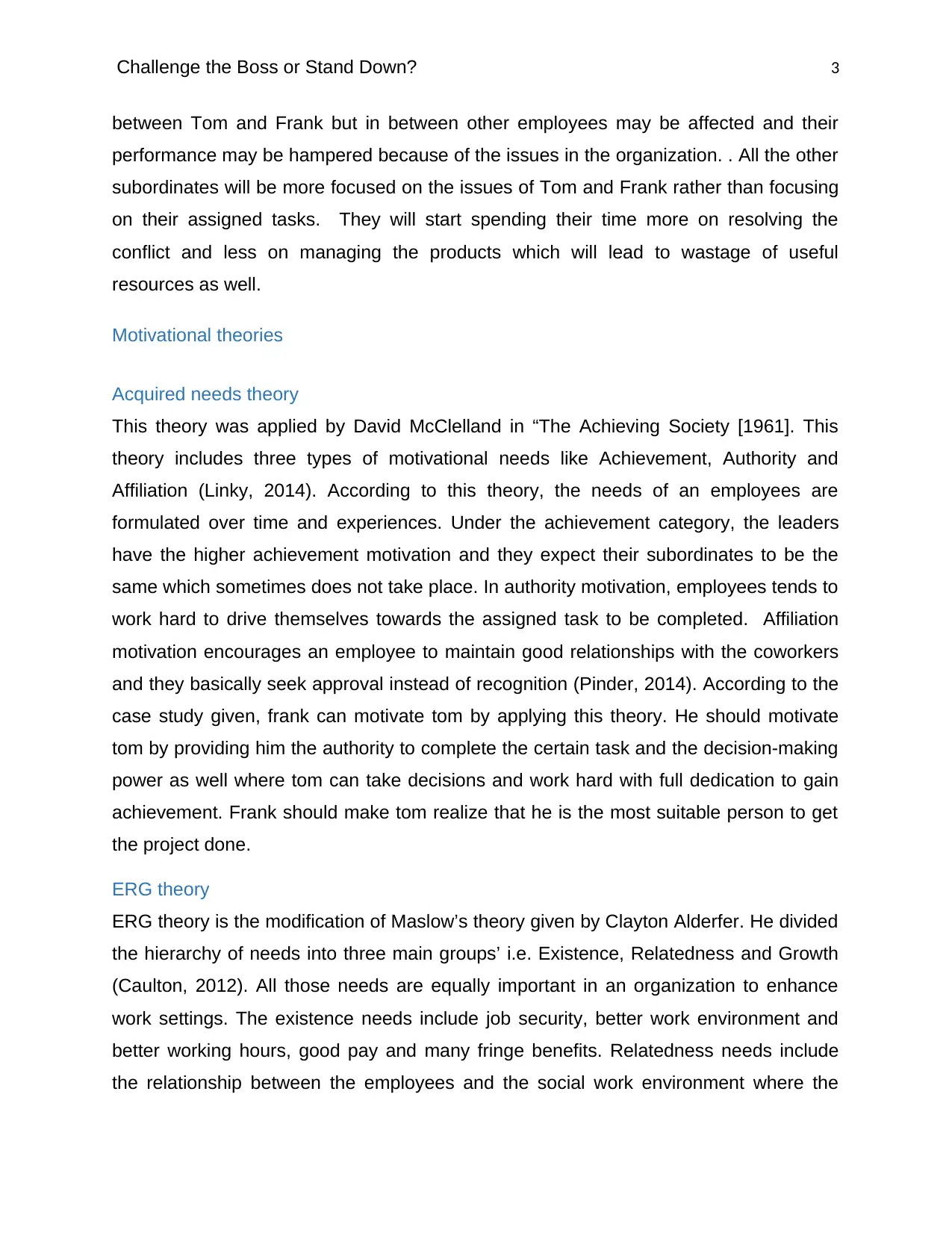
Challenge the Boss or Stand Down? 3
between Tom and Frank but in between other employees may be affected and their
performance may be hampered because of the issues in the organization. . All the other
subordinates will be more focused on the issues of Tom and Frank rather than focusing
on their assigned tasks. They will start spending their time more on resolving the
conflict and less on managing the products which will lead to wastage of useful
resources as well.
Motivational theories
Acquired needs theory
This theory was applied by David McClelland in “The Achieving Society [1961]. This
theory includes three types of motivational needs like Achievement, Authority and
Affiliation (Linky, 2014). According to this theory, the needs of an employees are
formulated over time and experiences. Under the achievement category, the leaders
have the higher achievement motivation and they expect their subordinates to be the
same which sometimes does not take place. In authority motivation, employees tends to
work hard to drive themselves towards the assigned task to be completed. Affiliation
motivation encourages an employee to maintain good relationships with the coworkers
and they basically seek approval instead of recognition (Pinder, 2014). According to the
case study given, frank can motivate tom by applying this theory. He should motivate
tom by providing him the authority to complete the certain task and the decision-making
power as well where tom can take decisions and work hard with full dedication to gain
achievement. Frank should make tom realize that he is the most suitable person to get
the project done.
ERG theory
ERG theory is the modification of Maslow’s theory given by Clayton Alderfer. He divided
the hierarchy of needs into three main groups’ i.e. Existence, Relatedness and Growth
(Caulton, 2012). All those needs are equally important in an organization to enhance
work settings. The existence needs include job security, better work environment and
better working hours, good pay and many fringe benefits. Relatedness needs include
the relationship between the employees and the social work environment where the
between Tom and Frank but in between other employees may be affected and their
performance may be hampered because of the issues in the organization. . All the other
subordinates will be more focused on the issues of Tom and Frank rather than focusing
on their assigned tasks. They will start spending their time more on resolving the
conflict and less on managing the products which will lead to wastage of useful
resources as well.
Motivational theories
Acquired needs theory
This theory was applied by David McClelland in “The Achieving Society [1961]. This
theory includes three types of motivational needs like Achievement, Authority and
Affiliation (Linky, 2014). According to this theory, the needs of an employees are
formulated over time and experiences. Under the achievement category, the leaders
have the higher achievement motivation and they expect their subordinates to be the
same which sometimes does not take place. In authority motivation, employees tends to
work hard to drive themselves towards the assigned task to be completed. Affiliation
motivation encourages an employee to maintain good relationships with the coworkers
and they basically seek approval instead of recognition (Pinder, 2014). According to the
case study given, frank can motivate tom by applying this theory. He should motivate
tom by providing him the authority to complete the certain task and the decision-making
power as well where tom can take decisions and work hard with full dedication to gain
achievement. Frank should make tom realize that he is the most suitable person to get
the project done.
ERG theory
ERG theory is the modification of Maslow’s theory given by Clayton Alderfer. He divided
the hierarchy of needs into three main groups’ i.e. Existence, Relatedness and Growth
(Caulton, 2012). All those needs are equally important in an organization to enhance
work settings. The existence needs include job security, better work environment and
better working hours, good pay and many fringe benefits. Relatedness needs include
the relationship between the employees and the social work environment where the
Paraphrase This Document
Need a fresh take? Get an instant paraphrase of this document with our AI Paraphraser
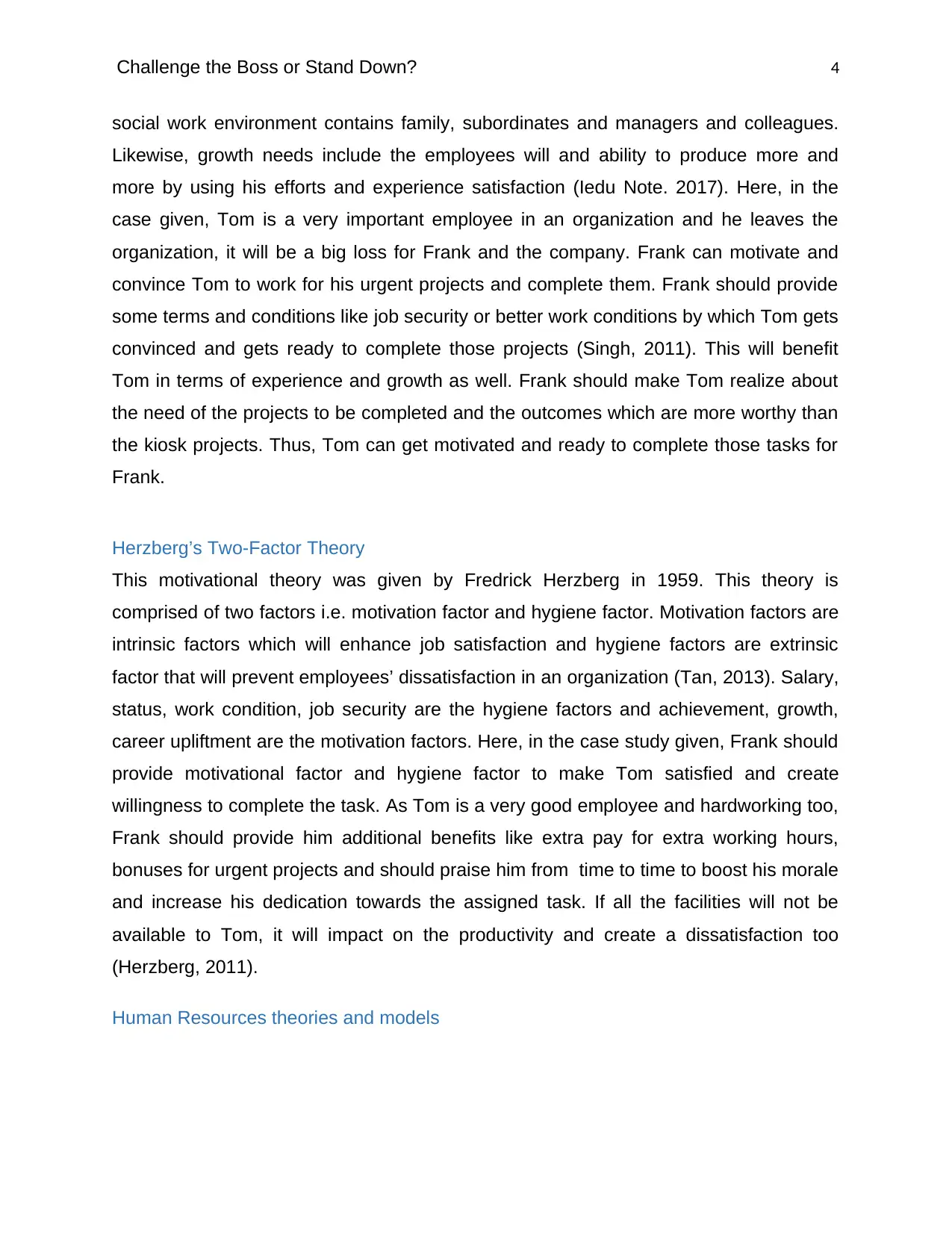
Challenge the Boss or Stand Down? 4
social work environment contains family, subordinates and managers and colleagues.
Likewise, growth needs include the employees will and ability to produce more and
more by using his efforts and experience satisfaction (Iedu Note. 2017). Here, in the
case given, Tom is a very important employee in an organization and he leaves the
organization, it will be a big loss for Frank and the company. Frank can motivate and
convince Tom to work for his urgent projects and complete them. Frank should provide
some terms and conditions like job security or better work conditions by which Tom gets
convinced and gets ready to complete those projects (Singh, 2011). This will benefit
Tom in terms of experience and growth as well. Frank should make Tom realize about
the need of the projects to be completed and the outcomes which are more worthy than
the kiosk projects. Thus, Tom can get motivated and ready to complete those tasks for
Frank.
Herzberg’s Two-Factor Theory
This motivational theory was given by Fredrick Herzberg in 1959. This theory is
comprised of two factors i.e. motivation factor and hygiene factor. Motivation factors are
intrinsic factors which will enhance job satisfaction and hygiene factors are extrinsic
factor that will prevent employees’ dissatisfaction in an organization (Tan, 2013). Salary,
status, work condition, job security are the hygiene factors and achievement, growth,
career upliftment are the motivation factors. Here, in the case study given, Frank should
provide motivational factor and hygiene factor to make Tom satisfied and create
willingness to complete the task. As Tom is a very good employee and hardworking too,
Frank should provide him additional benefits like extra pay for extra working hours,
bonuses for urgent projects and should praise him from time to time to boost his morale
and increase his dedication towards the assigned task. If all the facilities will not be
available to Tom, it will impact on the productivity and create a dissatisfaction too
(Herzberg, 2011).
Human Resources theories and models
social work environment contains family, subordinates and managers and colleagues.
Likewise, growth needs include the employees will and ability to produce more and
more by using his efforts and experience satisfaction (Iedu Note. 2017). Here, in the
case given, Tom is a very important employee in an organization and he leaves the
organization, it will be a big loss for Frank and the company. Frank can motivate and
convince Tom to work for his urgent projects and complete them. Frank should provide
some terms and conditions like job security or better work conditions by which Tom gets
convinced and gets ready to complete those projects (Singh, 2011). This will benefit
Tom in terms of experience and growth as well. Frank should make Tom realize about
the need of the projects to be completed and the outcomes which are more worthy than
the kiosk projects. Thus, Tom can get motivated and ready to complete those tasks for
Frank.
Herzberg’s Two-Factor Theory
This motivational theory was given by Fredrick Herzberg in 1959. This theory is
comprised of two factors i.e. motivation factor and hygiene factor. Motivation factors are
intrinsic factors which will enhance job satisfaction and hygiene factors are extrinsic
factor that will prevent employees’ dissatisfaction in an organization (Tan, 2013). Salary,
status, work condition, job security are the hygiene factors and achievement, growth,
career upliftment are the motivation factors. Here, in the case study given, Frank should
provide motivational factor and hygiene factor to make Tom satisfied and create
willingness to complete the task. As Tom is a very good employee and hardworking too,
Frank should provide him additional benefits like extra pay for extra working hours,
bonuses for urgent projects and should praise him from time to time to boost his morale
and increase his dedication towards the assigned task. If all the facilities will not be
available to Tom, it will impact on the productivity and create a dissatisfaction too
(Herzberg, 2011).
Human Resources theories and models
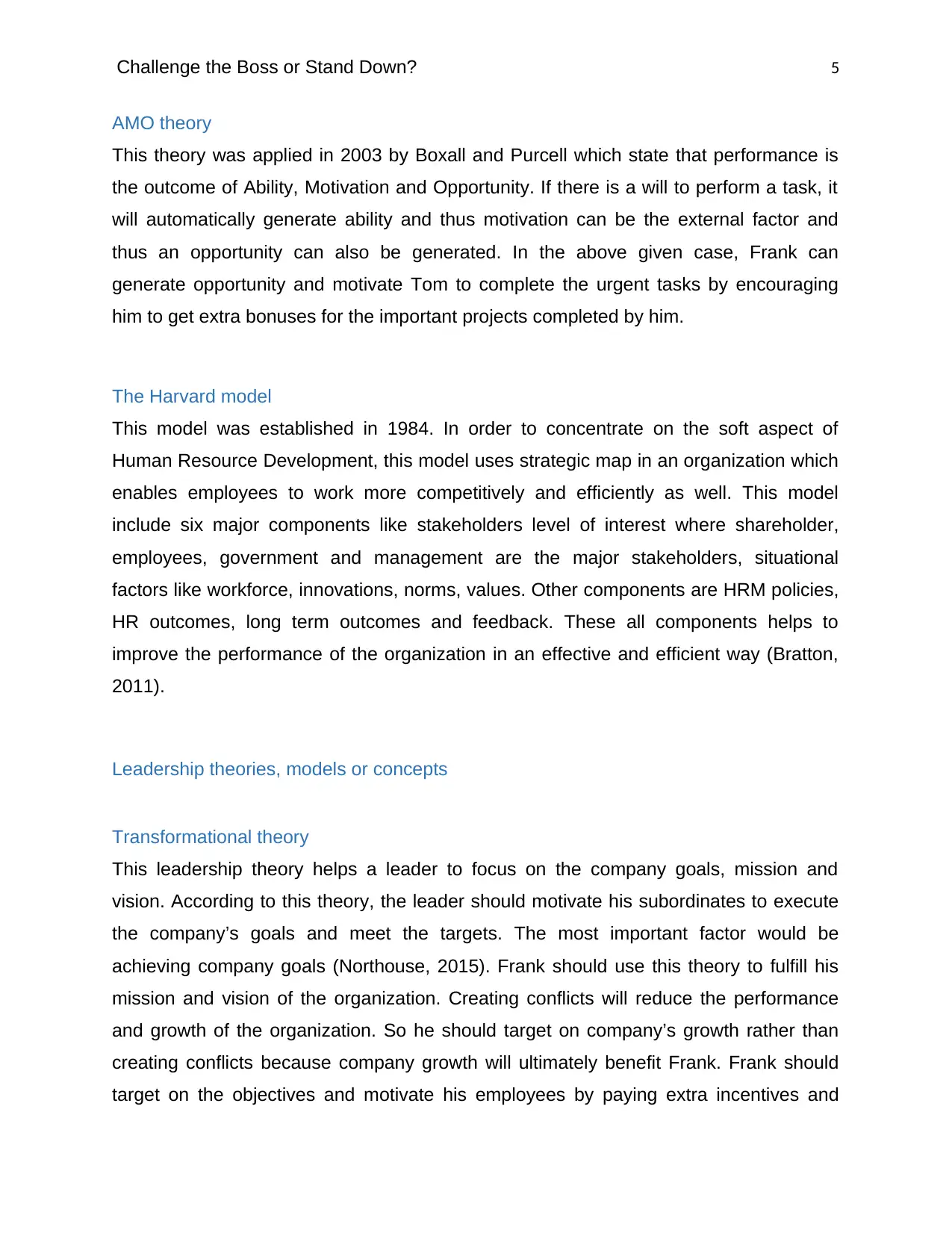
Challenge the Boss or Stand Down? 5
AMO theory
This theory was applied in 2003 by Boxall and Purcell which state that performance is
the outcome of Ability, Motivation and Opportunity. If there is a will to perform a task, it
will automatically generate ability and thus motivation can be the external factor and
thus an opportunity can also be generated. In the above given case, Frank can
generate opportunity and motivate Tom to complete the urgent tasks by encouraging
him to get extra bonuses for the important projects completed by him.
The Harvard model
This model was established in 1984. In order to concentrate on the soft aspect of
Human Resource Development, this model uses strategic map in an organization which
enables employees to work more competitively and efficiently as well. This model
include six major components like stakeholders level of interest where shareholder,
employees, government and management are the major stakeholders, situational
factors like workforce, innovations, norms, values. Other components are HRM policies,
HR outcomes, long term outcomes and feedback. These all components helps to
improve the performance of the organization in an effective and efficient way (Bratton,
2011).
Leadership theories, models or concepts
Transformational theory
This leadership theory helps a leader to focus on the company goals, mission and
vision. According to this theory, the leader should motivate his subordinates to execute
the company’s goals and meet the targets. The most important factor would be
achieving company goals (Northouse, 2015). Frank should use this theory to fulfill his
mission and vision of the organization. Creating conflicts will reduce the performance
and growth of the organization. So he should target on company’s growth rather than
creating conflicts because company growth will ultimately benefit Frank. Frank should
target on the objectives and motivate his employees by paying extra incentives and
AMO theory
This theory was applied in 2003 by Boxall and Purcell which state that performance is
the outcome of Ability, Motivation and Opportunity. If there is a will to perform a task, it
will automatically generate ability and thus motivation can be the external factor and
thus an opportunity can also be generated. In the above given case, Frank can
generate opportunity and motivate Tom to complete the urgent tasks by encouraging
him to get extra bonuses for the important projects completed by him.
The Harvard model
This model was established in 1984. In order to concentrate on the soft aspect of
Human Resource Development, this model uses strategic map in an organization which
enables employees to work more competitively and efficiently as well. This model
include six major components like stakeholders level of interest where shareholder,
employees, government and management are the major stakeholders, situational
factors like workforce, innovations, norms, values. Other components are HRM policies,
HR outcomes, long term outcomes and feedback. These all components helps to
improve the performance of the organization in an effective and efficient way (Bratton,
2011).
Leadership theories, models or concepts
Transformational theory
This leadership theory helps a leader to focus on the company goals, mission and
vision. According to this theory, the leader should motivate his subordinates to execute
the company’s goals and meet the targets. The most important factor would be
achieving company goals (Northouse, 2015). Frank should use this theory to fulfill his
mission and vision of the organization. Creating conflicts will reduce the performance
and growth of the organization. So he should target on company’s growth rather than
creating conflicts because company growth will ultimately benefit Frank. Frank should
target on the objectives and motivate his employees by paying extra incentives and
⊘ This is a preview!⊘
Do you want full access?
Subscribe today to unlock all pages.

Trusted by 1+ million students worldwide
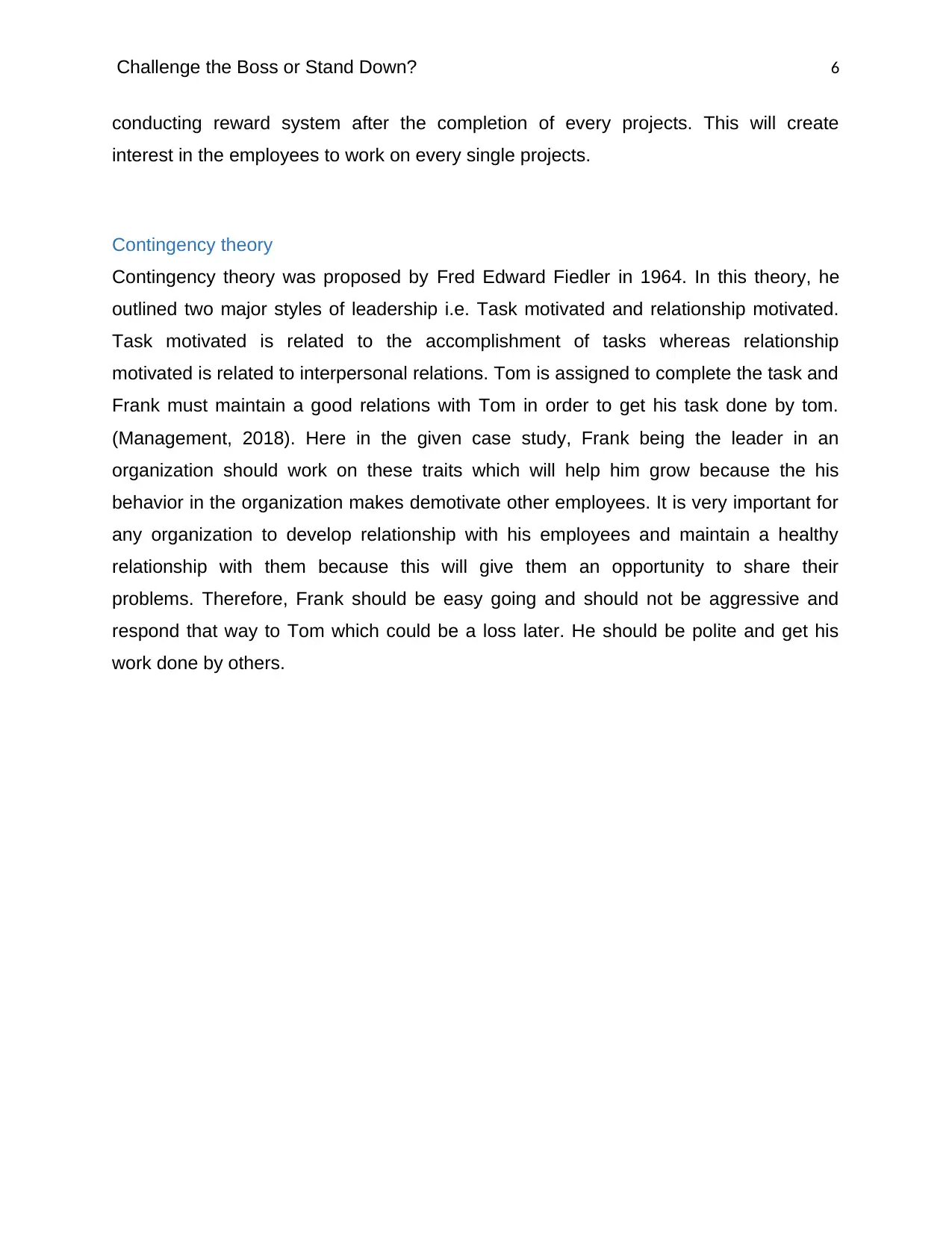
Challenge the Boss or Stand Down? 6
conducting reward system after the completion of every projects. This will create
interest in the employees to work on every single projects.
Contingency theory
Contingency theory was proposed by Fred Edward Fiedler in 1964. In this theory, he
outlined two major styles of leadership i.e. Task motivated and relationship motivated.
Task motivated is related to the accomplishment of tasks whereas relationship
motivated is related to interpersonal relations. Tom is assigned to complete the task and
Frank must maintain a good relations with Tom in order to get his task done by tom.
(Management, 2018). Here in the given case study, Frank being the leader in an
organization should work on these traits which will help him grow because the his
behavior in the organization makes demotivate other employees. It is very important for
any organization to develop relationship with his employees and maintain a healthy
relationship with them because this will give them an opportunity to share their
problems. Therefore, Frank should be easy going and should not be aggressive and
respond that way to Tom which could be a loss later. He should be polite and get his
work done by others.
conducting reward system after the completion of every projects. This will create
interest in the employees to work on every single projects.
Contingency theory
Contingency theory was proposed by Fred Edward Fiedler in 1964. In this theory, he
outlined two major styles of leadership i.e. Task motivated and relationship motivated.
Task motivated is related to the accomplishment of tasks whereas relationship
motivated is related to interpersonal relations. Tom is assigned to complete the task and
Frank must maintain a good relations with Tom in order to get his task done by tom.
(Management, 2018). Here in the given case study, Frank being the leader in an
organization should work on these traits which will help him grow because the his
behavior in the organization makes demotivate other employees. It is very important for
any organization to develop relationship with his employees and maintain a healthy
relationship with them because this will give them an opportunity to share their
problems. Therefore, Frank should be easy going and should not be aggressive and
respond that way to Tom which could be a loss later. He should be polite and get his
work done by others.
Paraphrase This Document
Need a fresh take? Get an instant paraphrase of this document with our AI Paraphraser
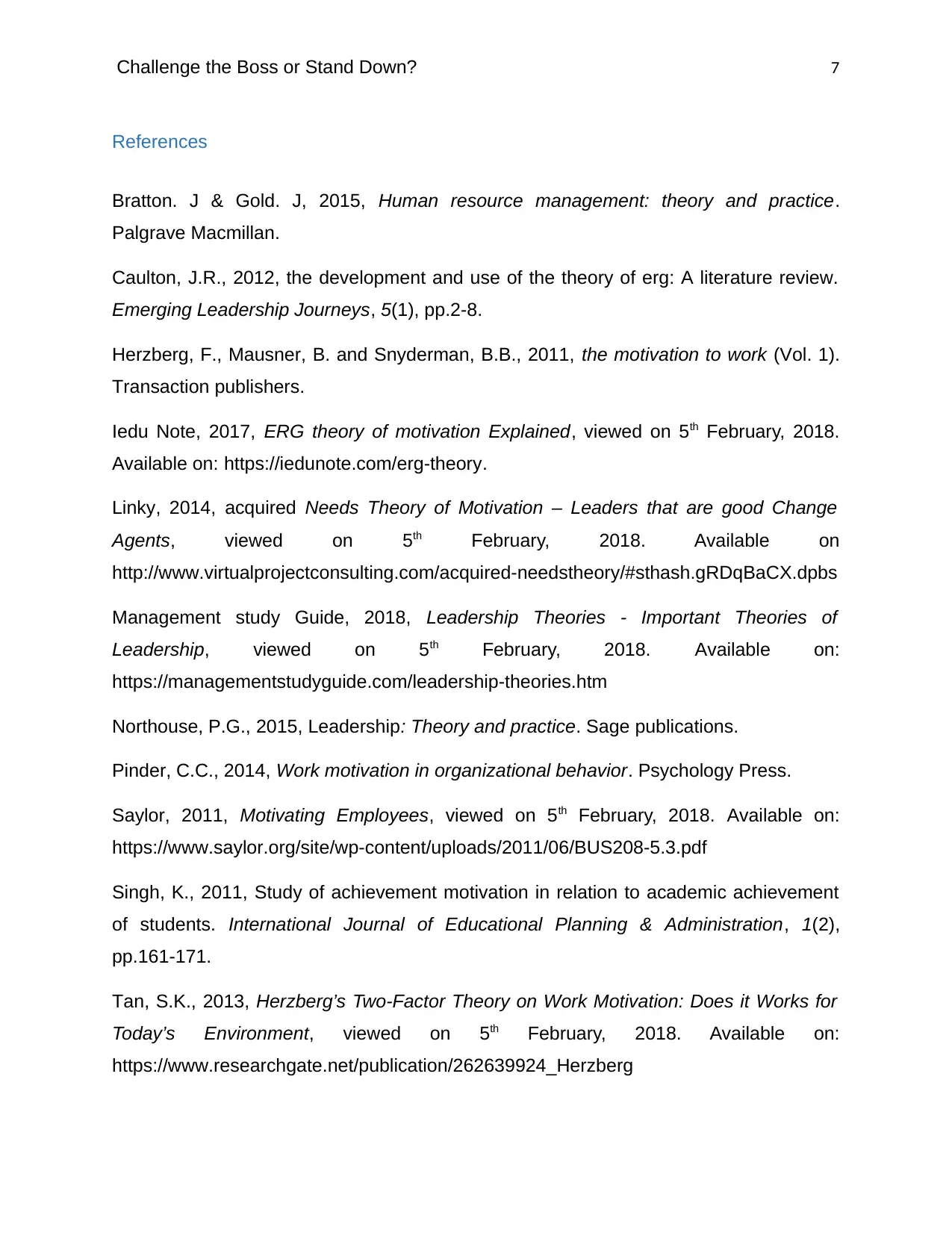
Challenge the Boss or Stand Down? 7
References
Bratton. J & Gold. J, 2015, Human resource management: theory and practice.
Palgrave Macmillan.
Caulton, J.R., 2012, the development and use of the theory of erg: A literature review.
Emerging Leadership Journeys, 5(1), pp.2-8.
Herzberg, F., Mausner, B. and Snyderman, B.B., 2011, the motivation to work (Vol. 1).
Transaction publishers.
Iedu Note, 2017, ERG theory of motivation Explained, viewed on 5th February, 2018.
Available on: https://iedunote.com/erg-theory.
Linky, 2014, acquired Needs Theory of Motivation – Leaders that are good Change
Agents, viewed on 5th February, 2018. Available on
http://www.virtualprojectconsulting.com/acquired-needstheory/#sthash.gRDqBaCX.dpbs
Management study Guide, 2018, Leadership Theories - Important Theories of
Leadership, viewed on 5th February, 2018. Available on:
https://managementstudyguide.com/leadership-theories.htm
Northouse, P.G., 2015, Leadership: Theory and practice. Sage publications.
Pinder, C.C., 2014, Work motivation in organizational behavior. Psychology Press.
Saylor, 2011, Motivating Employees, viewed on 5th February, 2018. Available on:
https://www.saylor.org/site/wp-content/uploads/2011/06/BUS208-5.3.pdf
Singh, K., 2011, Study of achievement motivation in relation to academic achievement
of students. International Journal of Educational Planning & Administration, 1(2),
pp.161-171.
Tan, S.K., 2013, Herzberg’s Two-Factor Theory on Work Motivation: Does it Works for
Today’s Environment, viewed on 5th February, 2018. Available on:
https://www.researchgate.net/publication/262639924_Herzberg
References
Bratton. J & Gold. J, 2015, Human resource management: theory and practice.
Palgrave Macmillan.
Caulton, J.R., 2012, the development and use of the theory of erg: A literature review.
Emerging Leadership Journeys, 5(1), pp.2-8.
Herzberg, F., Mausner, B. and Snyderman, B.B., 2011, the motivation to work (Vol. 1).
Transaction publishers.
Iedu Note, 2017, ERG theory of motivation Explained, viewed on 5th February, 2018.
Available on: https://iedunote.com/erg-theory.
Linky, 2014, acquired Needs Theory of Motivation – Leaders that are good Change
Agents, viewed on 5th February, 2018. Available on
http://www.virtualprojectconsulting.com/acquired-needstheory/#sthash.gRDqBaCX.dpbs
Management study Guide, 2018, Leadership Theories - Important Theories of
Leadership, viewed on 5th February, 2018. Available on:
https://managementstudyguide.com/leadership-theories.htm
Northouse, P.G., 2015, Leadership: Theory and practice. Sage publications.
Pinder, C.C., 2014, Work motivation in organizational behavior. Psychology Press.
Saylor, 2011, Motivating Employees, viewed on 5th February, 2018. Available on:
https://www.saylor.org/site/wp-content/uploads/2011/06/BUS208-5.3.pdf
Singh, K., 2011, Study of achievement motivation in relation to academic achievement
of students. International Journal of Educational Planning & Administration, 1(2),
pp.161-171.
Tan, S.K., 2013, Herzberg’s Two-Factor Theory on Work Motivation: Does it Works for
Today’s Environment, viewed on 5th February, 2018. Available on:
https://www.researchgate.net/publication/262639924_Herzberg
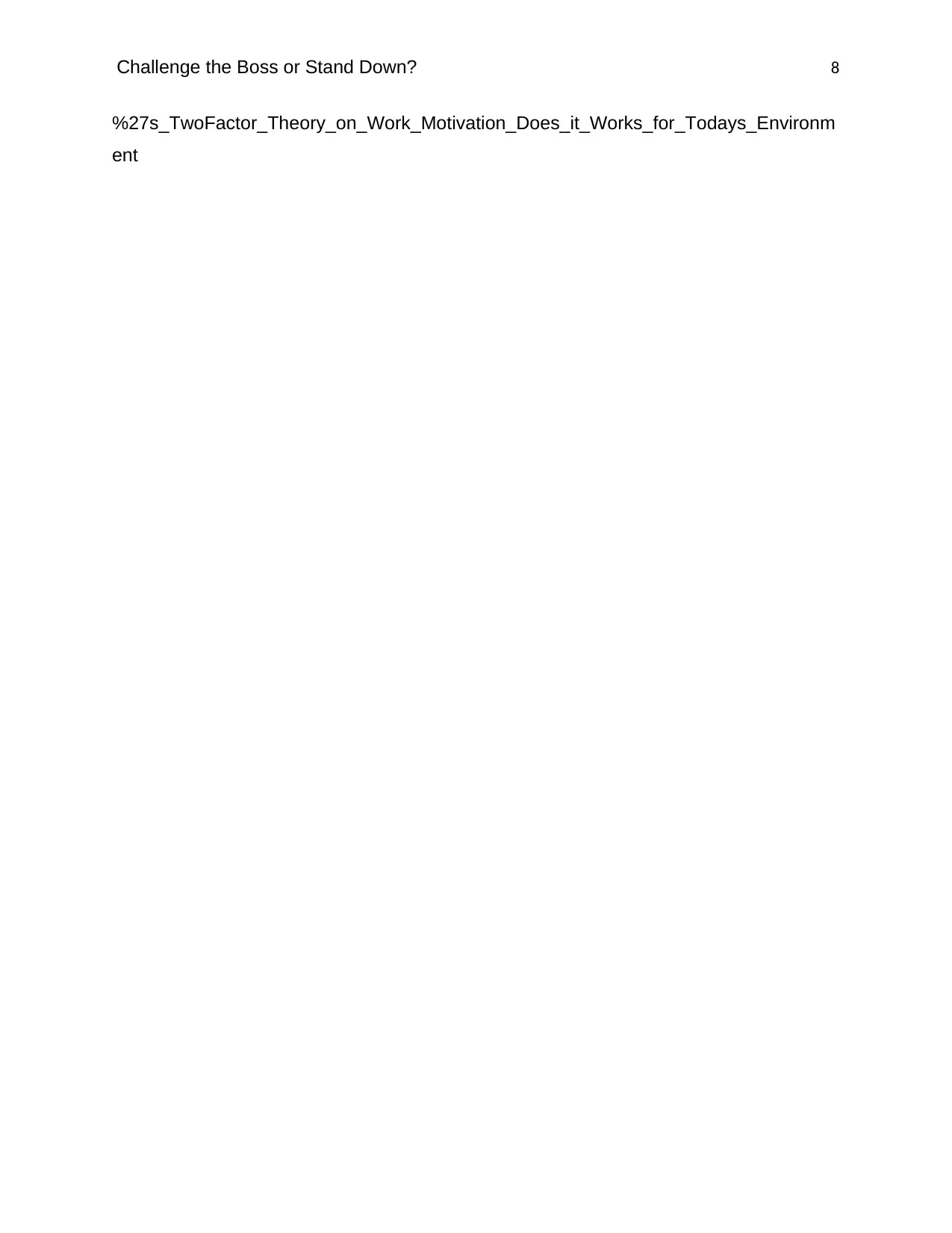
Challenge the Boss or Stand Down? 8
%27s_TwoFactor_Theory_on_Work_Motivation_Does_it_Works_for_Todays_Environm
ent
%27s_TwoFactor_Theory_on_Work_Motivation_Does_it_Works_for_Todays_Environm
ent
⊘ This is a preview!⊘
Do you want full access?
Subscribe today to unlock all pages.

Trusted by 1+ million students worldwide
1 out of 9
Related Documents
Your All-in-One AI-Powered Toolkit for Academic Success.
+13062052269
info@desklib.com
Available 24*7 on WhatsApp / Email
![[object Object]](/_next/static/media/star-bottom.7253800d.svg)
Unlock your academic potential
Copyright © 2020–2025 A2Z Services. All Rights Reserved. Developed and managed by ZUCOL.




